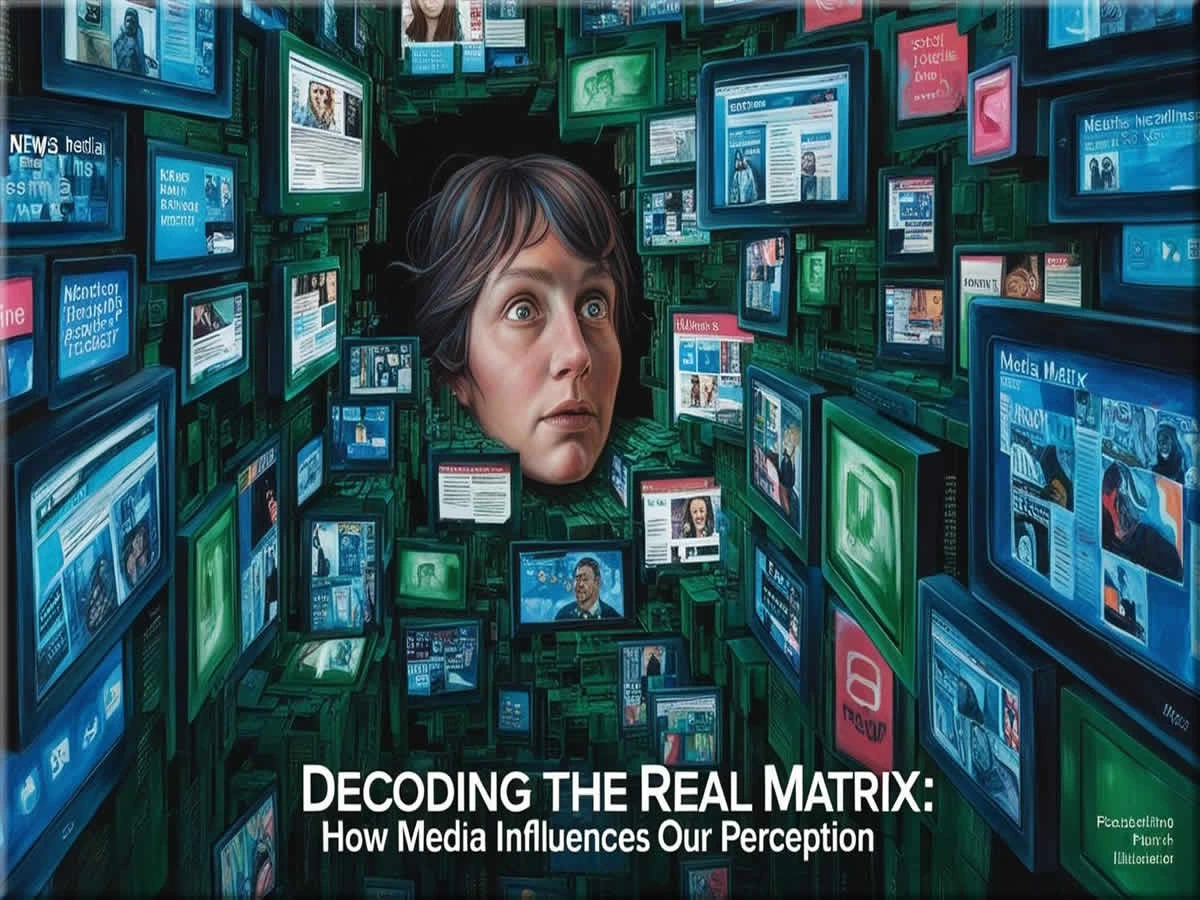
Decoding The Real Matrix: How Media Influence Our Perception
Media has always been a powerful tool for those who know how to wield it, especially governments. Around the world, state-controlled media outlets serve as extensions of policy, pushing narratives that align with governmental agendas. Let’s examine some examples of how media influence our perception.
In many countries, government influence over the media doesn’t just mean directives on broadcasting news but extends into intentional narrative crafting. China, for instance, uses state media to maintain the Communist Party’s image, control public perception, and influence international opinion. Similarly, Russia’s media landscape is closely monitored, with government agencies ensuring that only favorable images of leadership surface.
On the other hand, the situation is much different in Western countries like the USA. Everything is transparent to the point where the system does not feel threatened. However, their tactics are often sophisticated, utilizing talk shows, dramas, and even comedy to subtly reinforce desired views. In more direct ways, news stories could be outright designed to distract from political mishaps or failures, refocusing public attention on patriotic themes or manipulated controversies.
The brainwashing propaganda involves carefully entwining the truth with fiction to produce a seamless narrative. This approach becomes even more potent when packaged with elements of entertainment or fear, effectively engaging viewership while embedding specific messages.
This underlines why understanding media influence is crucial. As more governments recognize the power of media, being able to differentiate between balanced reporting and engineered narratives becomes vital. Media literacy isn’t just about consuming information; it’s about questioning its origins, motivations, and impacts.
The Power of Perception: Media’s Impact on Public Belief
The media doesn’t just tell stories; it creates our sense of reality. Individuals absorb numerous informative and persuasive messages daily, shaping how they perceive the world. Recognizing how these narratives are framed to sway public perception is essential because they are part of the Real Matrix.
Consider how news outlets shape a story. Through selective reporting, emphasis on specific aspects, or even the choice of words, media can depict incidents in a light that supports particular viewpoints. For example, coverage of protests can appear dangerous or justified depending on the press angle. This plays directly into the psychology of media consumption, where repeated exposure to particular framed messages solidifies these perceptions in the public consciousness.

Entertainment also occupies a unique position here. Movies, TV shows, and music subtly inject elements that can fortify or challenge societal norms. In some instances, they act to distract, offering escapism that might steer public focus away from pressing issues. The entertainment industry often bears the task of delivering messages in a digestible form, influencing their audience’s belief systems over time.
A modern-day illustration of distraction can be seen in high-voltage political climates, notably where celebrity news or scandals suddenly emerge to take center stage away from significant issues. In many ways, this aligns with the concept of ‘bread and circuses’—furnishing the populace with distraction and entertainment to ensure compliance and stability.
So, how should one respond? By developing a critical eye and questioning the underlying narratives presented in the media. Look for diverse viewpoints, verify facts with multiple sources, and reflect on the potential motivations behind specific media messages. Encourage discussions and debates that challenge surface impressions and explore the deeper intentions invested in media narratives.
Freedom of Expression vs. Controlled Narratives
The balance between freedom of expression and state-controlled narratives remains contentious in today’s complex world. On the one hand, the right to express opinions freely is a cornerstone of democratic societies, allowing individuals to challenge and critique governance. Conversely, states often impose restraints on media to maintain control and stability.
Censorship is seen in overt acts like jailing journalists or shutting down outlets and in more subtle forms like media conglomerates exercising self-censorship to avoid backlash. Even in countries known for free press, there are regular debates on whether true journalistic freedom exists or is subdued by political or corporate pressures.

This duality is evident in how mainstream media covers or does not cover different stories. Sensitive topics such as corruption scandals or human rights abuses might get quietly brushed aside, all orchestrated under the guise of protecting national interest or security.
In this environment, accessing diverse sources becomes crucial. Independent and grassroots journalism often counterbalances mainstream narratives, presenting alternative perspectives and undisclosed facts. But it’s a double-edged sword; as misinformation can spread unchecked through less-regulated media platforms, discerning the credibility of sources becomes an essential skill.
In the face of these challenges, embracing media literacy is key. This isn’t just about consuming content but critically engaging with it. Questioning sources, understanding media ownership, and recognizing bias are skills that need nurturing. They empower individuals to navigate the complex media landscape, ensuring that they’re informed participants in the discourse rather than passive consumers of propaganda.
The Brainwashing Cycle: Television as a Tool of Control
Television is one of the most pervasive influences shaping public belief and behavior. Its blend of vivid visuals and compelling content has the power to captivate and, at times, control. With screens in almost every home, television’s reach is unparalleled, making it an effective tool for shaping societal norms and individual habits.
Government-sponsored propaganda often leverages television to disseminate state-approved narratives, effectively guiding public discourse. Mainstream news broadcasts can subtly manipulate viewpoints by determining which stories to feature prominently and which to omit. This editorial power can steer collective attention, focusing on specific events or perspectives conducive to particular agendas.

Advertisements on television also play a crucial role in influencing consumer behavior. They’re crafted to elicit emotional responses, making viewers associate products with certain lifestyles or emotions. This keeps audiences in a cycle of consumerism, potentially prioritizing material gains over critical self-reflection or community engagement.
Moreover, the content children absorb through TV can shape their values and perceptions from an early age. Animated shows and children’s programming often present simplified resolutions to complex problems or perpetuate cultural stereotypes. As children are more impressionable, the media they consume can have lasting impacts on their worldview and values.
Addressing these influences starts at home. Encouraging discussions about what family members watch, setting viewing boundaries, and showcasing diverse content are practical steps toward fostering critical media consumption. By training children to question what they see and modeling this behavior ourselves, we counteract the one-way flow of influence that television often represents.
Vigilance is crucial in our digital age. As new media platforms gain popularity, cultivating a habit of assessing content critically can no longer be optional. Consider it essential for anyone aiming to make informed choices about the real versus the portrayed realities we encounter daily.
Discerning Truth from Fabrication: Towards a Media-Literate Society
As media continues to evolve, becoming proficient in identifying credible information is more crucial than ever. In a world flooded with content, separating fact from fabrication requires sharpened awareness and a proactive approach to consuming media.
One of the first steps toward media literacy is recognizing potential biases in reporting. This means considering who owns the media outlet and understanding the business or political interests that may influence its content. Awareness of these factors can help in assessing the reliability of the information being presented.

Verifying news through multiple sources is also a tenet of responsible media consumption. Cross-check facts with reputable international or independent outlets for a broader perspective on contentious issues. This practice not only aids in uncovering the truth but also provides insights into how different narratives are constructed.
Equipping oneself with the ability to identify sensationalism or emotionally charged language masquerading as news is equally crucial. These tactics are often used to grab attention or sway opinions, and recognizing them is key to not being unduly influenced.
Integrating media literacy as part of the curriculum is an effective strategy in educational settings. Helping students develop skills to evaluate media critically prepares them for an information-rich environment, fostering independence and critical thinking.
Ultimately, responsible media consumers are about active engagement rather than passive consumption. By questioning and analyzing the media we encounter, we become informed voices in society rather than echo chambers for disseminated narratives. This enriches our understanding and contributes a more transparent view of the Real Matrix.
Looking ahead, as digital platforms continue to grow in influence, the need for an informed and media-literate society becomes even more pressing. Embracing this responsibility ensures that as media evolves, so do the skills we need to navigate it wisely.
Related Topics










